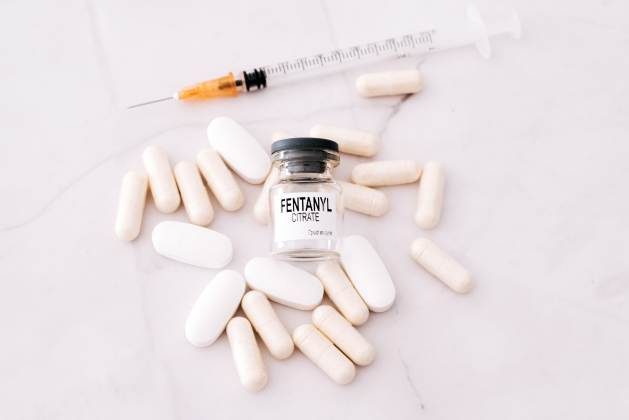Huge Increase in Transnational Crime in Asia’s ‘Golden Triangle’
TRANSCEND MEMBERS, 3 Jul 2023
Baher Kamal | Human Wrongs Watch - TRANSCEND Media Service
27 Jun 2023 – How come that in a world where technology is -or is about to be- able to detect an ant in a jungle, the traffickers of death continue to carry out their lucrative criminal activities everywhere and in all fields, from weapons to prostitution, enslavement and drugs to deadly fake medicines, through oil, gas and poisoned food.

In the United States and Canada, overdose deaths, predominantly driven by an epidemic of the non-medical use of fentanyl, continue to break records.
Credit: Shutterstock
In the specific case of Asia, a specialised organisation reports the Asian ‘Golden Triangle’ is where historically opium was grown to produce heroin for export, but where, in recent years, the trade of “even deadlier and more profitable synthetic drugs have taken over.”
In its June 2023 report, the UN Office on Drugs and Crime (UNODC) informs that East and Southeast Asian synthetic drug supply remains at ‘extreme levels’ and diversifies.
The report, “Synthetic Drugs in East and Southeast Asia: latest developments and challenges 2023”, confirms an expansion and diversification of synthetic drug production and trafficking in the region, while trafficking routes have shifted significantly.
“Thailand, Laos and Myanmar are at the frontlines of illicit trade in Asia dominated by transnational organised crime syndicates.”
Methamphetamine, ketamine…
‘High volumes’ of methamphetamine continue to be produced and trafficked in and from the region while the production of ketamine and other synthetic drugs has expanded.
“Transnational organised crime groups anticipate, adapt and try to circumvent what governments do, and in 2022 we saw them work around Thai borders in the Golden Triangle more than in the past,” saidJeremy Douglas, UNODC Regional Representative for Southeast Asia and the Pacific.
‘Unwanted’ to be seen
“Traffickers have continued to ship large volumes through Laos and northern Thailand, but at the same time they have pushed significant supply through central Myanmar to the Andaman Sea where it seems few were looking.”
Douglas added that criminal groups from across the region also started moving and reconnecting after lengthy pandemic border closures, with late 2022 and early 2023 patterns starting to look similar to 2019.
Hidden in “legal products”
Moreover, synthetic drugs containing a mixture of substances and sometimes “packaged alongside legal products” continue to be found throughout East and Southeast Asia, with serious health consequences for those who knowingly, or unknowingly, consume the products.
Moreover, the world drug problem is a complex issue that affects millions of people worldwide.
Many people who use drugs face stigma and discrimination, which can further harm their physical and mental health and prevent them from accessing the help they need, the UN warns on the occasion of the 2023 International Day Against Drug Abuse and Illicit Trafficking (26 June).
“Unprecedented” increase
The increase in the production of synthetic drugs in recent years has been “unprecedented” according to the UNODC Regional Representative.
It is not just drugs which are being trafficked across the region: chemical precursors to manufacture synthetic drugs are being illegally transported into Myanmar in quantities far larger than the drugs that are trafficked out, UNODC further explains.
Trafficking also in people, wildlife, timber…
In fact, a myriad of cross-borders issues, including drug and precursor chemical trafficking, migrant smuggling, human trafficking, wildlife and forestry crime, and, in some locations, the movement of terrorist fighters alongside public health and pandemic-related matters.
The impact of legalising the use of cocaine
Cannabis legalisation in parts of the world appears to have accelerated daily use and related health impacts, according to the World Drug Report 2022, which also details record rises in the manufacturing of cocaine, the expansion of synthetic drugs to new markets, and continued gaps in the availability of drug treatments, especially for women.
According to the report, around 284 million people aged 15-64 used drugs worldwide in 2020, a 26% increase over the previous decade.
“In Africa and Latin America, people under 35 represent the majority of people being treated for drug use disorders.”
Globally, the report estimates that 11.2 million people worldwide were injecting drugs. Around half of this number were living with hepatitis C, 1.4 million were living with HIV, and 1.2 million were living with both.
Reacting to these findings, UNODC Executive Director, Ghada Waly stated: “Numbers for the manufacturing and seizures of many illicit drugs are hitting record highs, even as global emergencies are deepening vulnerabilities.”
At the same time, mis-perceptions regarding the magnitude of the problem and the associated harms are depriving people of care and treatment and driving young people towards harmful behaviour, said Waly.
Key trends by region
In many countries in Africa and South and Central America, the largest proportion of people in treatment for drug use disorders are there primarily for cannabis use disorders. In Eastern and South-Eastern Europe and in Central Asia, people are most often in treatment for opioid use disorders.
In the United States and Canada, overdose deaths, predominantly driven by an epidemic of the non-medical use of fentanyl, continue to break records. Preliminary estimates in the United States point to more than 107,000 drug overdose deaths in 2021, up from nearly 92,000 in 2020.
Conflict zones magnets for synthetic drug production
This year’s report also highlights that illicit drug economies can flourish in situations of conflict and where the rule of law is weak, and in turn can prolong or fuel conflict.
Information from the Middle East and South-East Asia suggest that conflict situations can act as a magnet for the manufacture of synthetic drugs, which can be produced anywhere. This effect may be greater when the conflict area is close to large consumer markets.
Historically, parties to conflict have used drugs to finance conflict and generate income. The 2022 World Drug Report also reveals that conflicts may also disrupt and shift drug trafficking routes, as has happened in the Balkans and more recently in Ukraine.
A possible growing capacity to manufacture amphetamine in Ukraine
According to the UNODC report, “there was a significant increase in the number of reported clandestine laboratories in Ukraine, skyrocketing from 17 dismantled laboratories in 2019 to 79 in 2020. 67 out of these laboratories were producing amphetamines, up from five in 2019 – the highest number of dismantled laboratories reported in any given country in 2020.”
Gender treatment gap
Women remain in the minority of drug users globally yet tend to increase their rate of drug consumption and progress to drug use disorders more rapidly than men do. Women now represent an estimated 45-49% of users of amphetamines and non-medical users of pharmaceutical stimulants, pharmaceutical opioids, sedatives, and tranquillisers.
The treatment gap remains large for women globally. Although women represent almost one in two amphetamine users, they constitute only one in five people in treatment for amphetamine use disorders.
The World Drug Report also spotlights the wide range of roles fulfilled by women in the global cocaine economy, including cultivating coca, transporting small quantities of drugs, selling to consumers, and smuggling into prisons.
_____________________________________________
 Baher Kamal, a member of the TRANSCEND Network for Peace Development Environment, is an Egyptian-born, Spanish national, secular journalist, with over 45 years of professional experience — from reporter to special envoy to chief editor of national dailies and an international news agency. Baher is former Senior Advisor to the Director General of the international news agency IPS (Inter Press Service) and he also contributed to prestigious magazines such as TRANSCEND Media Service, GEO, Muy Interesante, and Natura, Spain. He is also publisher and editor of Human Wrongs Watch.
Baher Kamal, a member of the TRANSCEND Network for Peace Development Environment, is an Egyptian-born, Spanish national, secular journalist, with over 45 years of professional experience — from reporter to special envoy to chief editor of national dailies and an international news agency. Baher is former Senior Advisor to the Director General of the international news agency IPS (Inter Press Service) and he also contributed to prestigious magazines such as TRANSCEND Media Service, GEO, Muy Interesante, and Natura, Spain. He is also publisher and editor of Human Wrongs Watch.
Go to Original – human-wrongs-watch.net
Tags: Asia, Corruption, Crime, Southeast Asia
DISCLAIMER: The statements, views and opinions expressed in pieces republished here are solely those of the authors and do not necessarily represent those of TMS. In accordance with title 17 U.S.C. section 107, this material is distributed without profit to those who have expressed a prior interest in receiving the included information for research and educational purposes. TMS has no affiliation whatsoever with the originator of this article nor is TMS endorsed or sponsored by the originator. “GO TO ORIGINAL” links are provided as a convenience to our readers and allow for verification of authenticity. However, as originating pages are often updated by their originating host sites, the versions posted may not match the versions our readers view when clicking the “GO TO ORIGINAL” links. This site contains copyrighted material the use of which has not always been specifically authorized by the copyright owner. We are making such material available in our efforts to advance understanding of environmental, political, human rights, economic, democracy, scientific, and social justice issues, etc. We believe this constitutes a ‘fair use’ of any such copyrighted material as provided for in section 107 of the US Copyright Law. In accordance with Title 17 U.S.C. Section 107, the material on this site is distributed without profit to those who have expressed a prior interest in receiving the included information for research and educational purposes. For more information go to: http://www.law.cornell.edu/uscode/17/107.shtml. If you wish to use copyrighted material from this site for purposes of your own that go beyond ‘fair use’, you must obtain permission from the copyright owner.